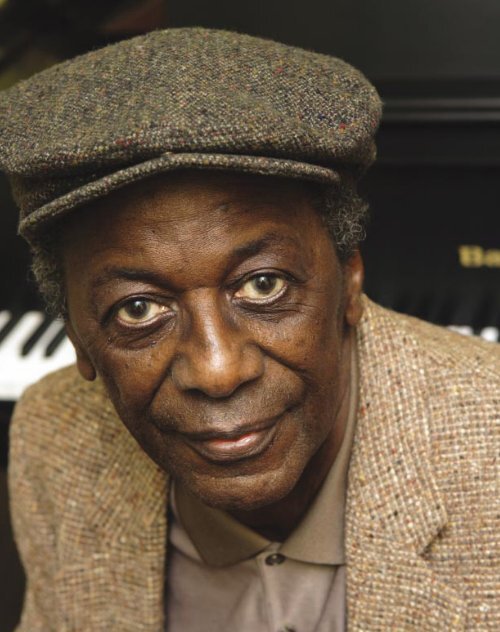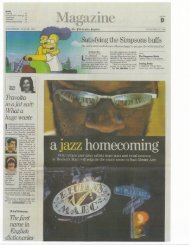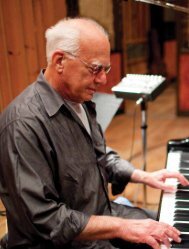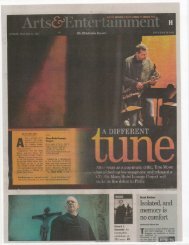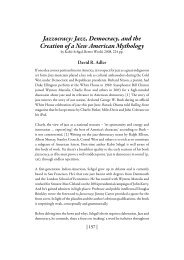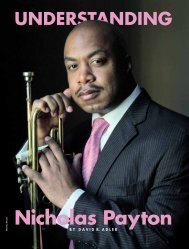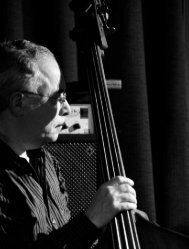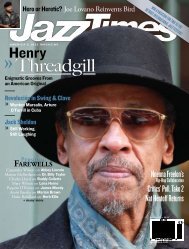050-054 Hill 04 - David R. Adler
050-054 Hill 04 - David R. Adler
050-054 Hill 04 - David R. Adler
You also want an ePaper? Increase the reach of your titles
YUMPU automatically turns print PDFs into web optimized ePapers that Google loves.
Nearing 70,<br />
pianist Andrew<br />
Once<br />
<strong>Hill</strong> rejoins<br />
the Blue Note<br />
roster with his<br />
new album,<br />
Time Lines,<br />
featuring some<br />
of the freshest<br />
music of his<br />
career.<br />
More,<br />
Jazz With Feeling<br />
BY DAVID R. ADLER<br />
“You’re not trapped in<br />
that room, you know,”<br />
Andrew <strong>Hill</strong> called out<br />
from his kitchen as he<br />
heated brandy and cider<br />
on the stovetop. It was a<br />
cold day in Jersey City,<br />
N.J., but <strong>Hill</strong>’s welcome<br />
could hardly have been<br />
warmer. Granted, reports<br />
of his gnomic, roundabout<br />
style of conversation<br />
are true. His mild<br />
stammer and bouts of<br />
coughing—a sign of his<br />
struggle with lung cancer—make<br />
him all the<br />
more difficult to follow.<br />
But he is also empathic<br />
and generous. His endearing,<br />
high-pitched laugh is<br />
spontaneous and nothing<br />
short of musical. Though<br />
frail, he is positive, full of<br />
fun. “I was talented but<br />
crazy, semiautistic and<br />
eccentric,” he has said of<br />
his youth. This may be<br />
the stuff of genius, but in<br />
<strong>Hill</strong>’s case it is not in the<br />
least forbidding.<br />
At the age of 26, <strong>Hill</strong><br />
altered jazz history,<br />
recording five visionary<br />
albums for Blue Note in<br />
just eight months in<br />
1963 and 1964. In the<br />
pace and uniqueness of<br />
his achievements, he<br />
rivaled more famous<br />
labelmates such as<br />
Herbie Hancock and<br />
Wayne Shorter. Among<br />
his collaborators were<br />
Eric Dolphy, Kenny<br />
Dorham, Bobby<br />
Hutcherson, Freddie<br />
Hubbard, Joe<br />
Henderson, Richard<br />
Davis, Roy Haynes,<br />
Elvin Jones and Tony<br />
Williams. <strong>Hill</strong> made several<br />
more records for<br />
Blue Note as the ’60s<br />
PHOTOGRAPHS BY JOHN ABBOTT<br />
progressed, but much of<br />
the music remained in<br />
the vaults. He left New<br />
York in 1970 and<br />
recorded sporadically for<br />
other labels over the<br />
next two decades,<br />
becoming, in Gary<br />
Giddins’ words, an “outlying<br />
cult figure.”<br />
Anthony Braxton, in the<br />
liner notes to his Nine<br />
Compositions (<strong>Hill</strong>)<br />
2000, wrote: “This is a<br />
private musical universe<br />
that is not always appreciated<br />
by the greater jazz<br />
business complex.”
52<br />
In 1989, <strong>Hill</strong> grew a bit more visible, reuniting<br />
with Blue Note to release Eternal Spirit, followed<br />
by But Not Farewell. Aficionados greeted<br />
his rare New York concerts as major events. In<br />
1995, after years of low-profile playing and<br />
teaching in California and Oregon, <strong>Hill</strong> (who is<br />
originally from Chicago) returned to the East<br />
Coast and began “participating again,” as he puts<br />
it. He now shares a modest three-story house<br />
across the river from Manhattan with his third<br />
wife, Joanne. His second wife, organist Laverne<br />
Gillette, died in 1989. (He lightheartedly<br />
declines to name his first wife.)<br />
Frank Kimbrough, a fellow pianist and longtime<br />
friend, remembers: “When [Andrew] told me<br />
he was coming back to New York, it excited me a<br />
great deal, because at that point there were young<br />
musicians who had grown up listening to his music.<br />
I knew he’d find lots of people to play with. I knew<br />
he would have a resurgence.” Mosaic Records’<br />
seven-disc box set, comprising <strong>Hill</strong>’s 1963-66 Blue<br />
Note work, helped lay the foundation.<br />
Later in the ’90s, Kimbrough visited <strong>Hill</strong> in<br />
the hospital after minor surgery. “I peeked into<br />
his room and saw him lying there. I knocked<br />
quietly and he sprang out of bed—I couldn’t<br />
believe it. He said, ‘Hey, come on, let’s go to the<br />
lounge. I’m going to put together a new band.’”<br />
<strong>Hill</strong> envisioned a sextet with the same instrumentation<br />
as his 1964 landmark Point of<br />
JAZZTIMES >> APRIL 2006<br />
Departure. “We sat in the hospital lounge and<br />
discussed who should be in that band,”<br />
Kimbrough recalls. <strong>Hill</strong> soon formed the group<br />
that would record Dusk for Palmetto in 2000.<br />
After Dusk came <strong>Hill</strong>’s big-band offering A<br />
Beautiful Day (musically directed by trumpeter<br />
Ron Horton). Gigs became more frequent. <strong>Hill</strong><br />
appeared overseas with his Anglo-American Big<br />
Band, featuring Horton and the sextet with such<br />
top British players as Denys Baptiste, Jason<br />
Yardey and Byron Wallen. (A recording is<br />
planned for 2006.) In 2003 <strong>Hill</strong> won Denmark’s<br />
JAZZPAR Prize and recorded The Day the World<br />
Stood Still with an American-Scandinavian<br />
ensemble. Blue Note began reissuing <strong>Hill</strong>’s early<br />
albums in earnest, including the priceless and<br />
long-lost Passing Ships and Dance With Death. In<br />
2005 Mosaic brought out its 16th “Select” edi-<br />
tion, a three-disc box containing yet more of<br />
<strong>Hill</strong>’s Blue Note sessions: astonishing, polyglot<br />
work that spanned the years 1967 to 1970, most<br />
of it previously unheard. And Test of Time<br />
Records reissued <strong>Hill</strong>’s three mid-’70s titles for<br />
East Wind (Hommage, Blue Black and Nefertiti).<br />
Conditions were ripe for <strong>Hill</strong> to ink his third<br />
Blue Note contract. Time Lines, the resulting<br />
album, can leave you speechless. It features trumpeter<br />
Charles Tolliver, himself an underrated<br />
master, a presence on Dance With Death and two<br />
of <strong>Hill</strong>’s Mosaic Select sessions from January<br />
1970. Joining Tolliver and <strong>Hill</strong> on Time Lines are<br />
three younger musicians well established on the<br />
New York scene: Gregory Tardy on reeds, John<br />
Hebert on bass and Eric McPherson on drums.<br />
<strong>Hill</strong> lauds their ability to play “three or four different<br />
ways. Whenever you hit a musical mood,<br />
they can enter it.” He casts doubt on the alleged<br />
creativity deficit among younger players: “I hear<br />
about everything that they’re not. Very few people<br />
talk about everything they are. There are so<br />
many flowers on the scene, it’s utterly amazing.”<br />
Younger musicians also forestall what <strong>Hill</strong><br />
calls “chronological disengagement,” which is<br />
simpler than it sounds: “[Young] people might<br />
look at the bandstand and say, ‘Well, he looks<br />
like my uncle.’ When they see someone their<br />
age participating, that gives them a different<br />
type of visual reference.”<br />
“These magic moments, when the<br />
rhythms and harmonies extend themselves<br />
and jell together and the people<br />
become another instrument. These are<br />
things that are priceless and can’t be<br />
learned; they can only be felt.”<br />
Listening to Time Lines, there’s no mistaking<br />
what Nat Hentoff, in the liner notes to Shades<br />
(1986), meant by “the time-within-time-withintime<br />
of Andrew <strong>Hill</strong>.” Richard Cook and Brian<br />
Morton, discussing <strong>Hill</strong>’s earlier work in The<br />
Penguin Guide to Jazz on CD, refer to tempos that<br />
are “too subliminal to be strictly counted,” harmonic<br />
language “that isn’t so much minor-key as<br />
surpassingly ambiguous….” These elements are<br />
present on Time Lines, although the tone colors of<br />
the title track are disarmingly bright. Tardy festoons<br />
the album with ravishing clarinet and bass<br />
clarinet. The piano sound is vast. “I’ve made it a<br />
project to figure out how to record the piano,”<br />
<strong>Hill</strong> says. “The key is not to approach it as an<br />
accompanying instrument. Instead of instruments<br />
accompanying each other, have equal volume<br />
on all, so they all can stand on their own.
Otherwise it throws off the quality of the performance.”<br />
Michael Cuscuna, who produced<br />
Time Lines and the Mosaic sets and also recorded<br />
<strong>Hill</strong> for the Freedom label in the mid-’70s, had<br />
no trouble harmonizing with <strong>Hill</strong>’s intentions.<br />
Bob Blumenthal, in the reissue liners to<br />
Judgment!, sheds light on a disagreement between<br />
Leonard Feather and A.B. Spellman over the categorization<br />
of <strong>Hill</strong>’s music. Spellman, in his Black<br />
Fire notes, placed <strong>Hill</strong> within the second wave of<br />
the avant-garde. Feather, in his original Judgment!<br />
essay, cautioned listeners against this term, making<br />
a case for <strong>Hill</strong> as part of the mainstream postbop<br />
continuum. Classifying <strong>Hill</strong> is no less contentious<br />
today. In The Oxford Companion to Jazz,<br />
Blumenthal aptly describes <strong>Hill</strong>’s approach as “a<br />
way of opening up jazz through an exploration of<br />
complex chorus structures rather than the obliteration<br />
of formal signposts.” <strong>Hill</strong>, in a typically<br />
offhanded but suggestive aside, volunteers his<br />
own description: “It’s jazz with a feeling.”<br />
<strong>Hill</strong>’s 1967 Mosaic Select sessions with Robin<br />
Kenyatta are decidedly “out.” The same can be<br />
said for his 1980 trio date with Alan Silva and<br />
Freddie Waits, Strange Serenade, or his 1966<br />
Involution tracks with Sam Rivers. But <strong>Hill</strong> has<br />
written expressively in an “inside” vein<br />
(“Laverne,” “East 9th Street,” “Samba Rasta”);<br />
delved deep into the blues (“Yokada Yokada,”<br />
“Chilly Mac,” “Today,” “Tail Feather,” “The<br />
Rumproller”); crafted simple groove-based tunes<br />
like “Ocho Rios,” “Soul Special” and “Diddy<br />
Wah”; and burned over fast but abstract 4/4<br />
swing on pieces like “Interfusion” and “Chained”<br />
(see sidebar). He has made use of multipercussion<br />
(Compulsion), two basses (Smoke Stack), choral<br />
voices (Lift Every Voice) and strings (the Mosaic<br />
Select “B” sessions). In <strong>Hill</strong>’s world, moreover,<br />
strings are not a sweetener; on the contrary, they<br />
heighten dissonance and otherworldliness.<br />
At the time of this interview, <strong>Hill</strong> was working<br />
on a string quartet he plans to premiere at<br />
New York’s Merkin Hall in spring 2006. Booting<br />
up his computer, he let roughly 80 bars play<br />
through headphones. The music—spare, harmonically<br />
dense and texturally engrossing—<br />
brought <strong>Hill</strong>’s decades-ago studies with Paul<br />
Hindemith rushing to mind. “He was a nice<br />
man,” <strong>Hill</strong> recalls. “I could do certain things naturally.<br />
One of his things was like G7 with F, G,<br />
A and B together—cluster tones. I could hit<br />
things like that and understand them. But what<br />
we talked about was musical shapes and spaces<br />
more than harmony.”<br />
There are certain <strong>Hill</strong>-like shapes and spaces in<br />
the “Entombment” movement from Mathis der<br />
Maler (hear <strong>Hill</strong>’s “Ode to Infinity”), or in Glenn<br />
Gould’s rendering of the Hindemith piano<br />
sonatas. (Incidentally, <strong>Hill</strong> uses two violas in his<br />
1969 string writing. Hindemith was a violist.)<br />
“In Chicago they expected you to be good at<br />
everything,” <strong>Hill</strong> remarked in the liner notes to<br />
The Day the World Stood Still. He met that challenge<br />
handily, backing Charlie Parker and Miles<br />
Davis on their respective jaunts through the<br />
Midwest and later accompanying the singers<br />
Dinah Washington, Johnny Hartman and Al<br />
Hibbler. He debuted as a leader in the mid-’50s<br />
with two singles (four songs in all) for Ping<br />
Records, followed by a Warwick LP with Malachi<br />
Favors and James Slaughter called So in Love, reissued<br />
by Fresh Sound in 2001. Soon thereafter he<br />
made notable sideman appearances with Rahsaan<br />
Roland Kirk (Domino), Walt Dickerson (To My<br />
Queen), Hank Mobley (No Room for Squares) and<br />
Joe Henderson (Our Thing).<br />
Blue Note’s Alfred Lion saw <strong>Hill</strong> as a successor<br />
to Thelonious Monk and Herbie Nichols.<br />
<strong>Hill</strong>’s roots in the “percussive school” of jazz<br />
piano, reaching back to stride, are especially clear<br />
on his solo discs: Hommage, Live at Montreux,<br />
From California With Love, Faces of Hope, Verona<br />
Rag and Les Trinitaires. Given his emphasis on<br />
original material now and in the ’60s, it is easy to<br />
underestimate his versatility, as Gary Giddins did<br />
in a 1996 review reprinted in Weather Bird:<br />
“[<strong>Hill</strong>’s] opening set at Iridium…settled any fears<br />
that he might actually have learned a standard<br />
over the years….” In fact, <strong>Hill</strong> has performed a<br />
number of standards on recordings from 1974 to<br />
1998, including “Darn That Dream,” “Come<br />
Sunday,” “Afternoon in Paris,” “Invitation,”<br />
“Sophisticated Lady,” “What’s New” and “I’ll Be<br />
Seeing You.” On his first album, So in Love, he<br />
plays only two originals and is positively Red<br />
Garland-esque on “Body and Soul,” “Old Devil<br />
Moon” and several others.<br />
It made sense some years ago for Blumenthal<br />
to conclude that <strong>Hill</strong>, thanks to extended<br />
A Day in the Life<br />
Andrew <strong>Hill</strong>’s Mosaic<br />
Select “C” session, a trio<br />
date with bassist Ron<br />
Carter and drummer Teddy<br />
Robinson, was shelved until<br />
1982, when it was prepared<br />
for release as Chained.<br />
Instead, it remained buried<br />
in the Blue Note vaults until<br />
2005. Comprising seven<br />
tracks (including an alternate<br />
take of “Nine at the<br />
Bottom”), the hard-hitting<br />
session is notable for its<br />
surprises: <strong>Hill</strong> plays soprano<br />
sax on “Six at the Top” and<br />
organ on “Resolution” and<br />
“Nine at the Bottom.” The<br />
recording date is listed as<br />
May 17, 1967. Location:<br />
Rudy Van Gelder’s studio in<br />
Englewood Cliffs, N.J.<br />
At this time, of course,<br />
Ron Carter was at the peak<br />
of his tenure with the Miles<br />
Davis Quintet. Incredibly,<br />
the discography in The<br />
Miles Davis Quintet, 1965-<br />
68: The Complete Columbia<br />
Studio Recordings<br />
(Columbia/Legacy) contains<br />
an entry for May 17, 1967,<br />
when Davis was in the<br />
midst of recording<br />
Sorcerer. On this particular<br />
day, at 30th Street Studios<br />
in Manhattan, the quintet<br />
recorded the master takes<br />
of “The Sorcerer” and<br />
“Masqualero” and an alter-<br />
nate of the latter. On the<br />
previous day they recorded<br />
“Limbo” and “Vonetta.” The<br />
following week they waxed<br />
“Prince of Darkness” and<br />
“Pee Wee.”<br />
It’s something to imagine:<br />
Ron Carter rushing from<br />
an Andrew <strong>Hill</strong> session in<br />
New Jersey to a Miles Davis<br />
session in New York (or vice<br />
versa). In a brief phone<br />
interview, however, the<br />
bassist was skeptical. Most<br />
Miles Davis sessions began<br />
in the early afternoon, he<br />
recalled. But <strong>Hill</strong>’s session,<br />
he estimated, would have<br />
started around 10 a.m. and<br />
kept him busy until about 4<br />
p.m. “The process was we’d<br />
go to a place called Len<br />
Oliver’s and rehearse for<br />
two days—and then go to<br />
Rudy’s the following day,”<br />
Carter says. “Alfred [Lion]<br />
would bring sandwich supplies:<br />
bread, knives, cold<br />
cuts and stuff, and we’d do<br />
the date until it got done.”<br />
Additional research<br />
revealed Carter’s skepticism<br />
to be warranted. Michael<br />
Cuscuna contacted Van<br />
Gelder, who consulted his<br />
studio log and found that<br />
the Chained session took<br />
place on May 19, not May<br />
17. “Apparently, Alfred<br />
entered the wrong date,”<br />
Cuscuna says.<br />
Still, it is striking that<br />
Carter helped create these<br />
extraordinary documents in<br />
the space of three days.<br />
Listening to Sorcerer and<br />
Chained with this in mind is<br />
a new and revelatory experience.<br />
Both albums transcend<br />
the mainstream jazz<br />
conception of the time yet<br />
can’t be pigeonholed as<br />
avant-garde. In the ferocity<br />
of <strong>Hill</strong>’s “Interfusion,” or the<br />
darkly drawn mysteries of<br />
his “MOMA,” there are hints<br />
of the compositional economy<br />
and improvisational<br />
abandon of Miles’ second<br />
quintet.<br />
“What sticks in my mind,”<br />
Carter recalls, “was I wondered<br />
why Andrew didn’t<br />
play more trio, since he did it<br />
very well. I also wish I had<br />
played with him more outside<br />
the studio, to see what<br />
kind of development we<br />
could bring to these tunes.”<br />
Carter went on to record<br />
with <strong>Hill</strong> on Grass Roots,<br />
Passing Ships, the Mosaic<br />
Select “A” and “B2” sessions,<br />
and the six 1970 bonus<br />
tracks to be found on Lift<br />
Every Voice. <strong>Hill</strong> returned to<br />
the trio format in subsequent<br />
years with Invitation,<br />
Nefertiti and Strange<br />
Serenade. DAVID R. ADLER<br />
JAZZTIMES.COM 53
54<br />
absences from the performing circuit, has had<br />
“little impact on fellow musicians.” But evidence<br />
is beginning to indicate otherwise. Along with<br />
percussive-school peers like Jaki Byard, Muhal<br />
Richard Abrams and Randy Weston, <strong>Hill</strong> has<br />
energized today’s young modernists, in particular<br />
Vijay Iyer and Jason Moran. In a recent issue of<br />
Down Beat, Iyer cited <strong>Hill</strong>’s Smoke Stack as an<br />
example of “the perfect record”; in Signal to Noise<br />
he credited <strong>Hill</strong> as “a major influence on my own<br />
playing and composing, as well as a friend and<br />
frequent advisor.” Moran, who performed piano<br />
duos with <strong>Hill</strong> at Merkin Hall in 20<strong>04</strong>, based his<br />
“Gangsterism on Canvas” partly on a melodic<br />
fragment from <strong>Hill</strong>’s “Erato.”<br />
“The incredible thing about Andrew,” says<br />
bassist Scott Colley, “is the way he writes for<br />
horns, and can imply so much harmony, sometimes<br />
over a very simple chord base. I’ve tried to<br />
emulate that in my own writing.” Ron Horton,<br />
a bandmate of Colley’s in the Dusk sextet and the<br />
big band, had been transcribing <strong>Hill</strong>’s music for<br />
years when <strong>Hill</strong> decided to hire him. (His transcription<br />
of “Erato” can be heard on Ben Allison’s<br />
Buzz.) Another <strong>Hill</strong> devotee, Greg Osby, took<br />
part in the pianist’s late-’80s renaissance and then<br />
featured him on The Invisible Hand in 2000—<br />
the same year that Anthony Braxton recorded<br />
<strong>Hill</strong>’s compositions on two discs for CIMP.<br />
Examples of <strong>Hill</strong>’s influence continue to<br />
mount. Nels Cline, the West Coast avant-gardist<br />
and guitarist for Wilco, has just recorded an<br />
JAZZTIMES >> APRIL 2006<br />
album of <strong>Hill</strong>’s compositions for Cryptogramophone,<br />
with a sextet featuring clarinetist Ben<br />
Goldberg and trumpet veteran Bobby Bradford.<br />
“When I was discovering jazz in my late teens,”<br />
Cline recalls, “my brother [drummer] Alex and I<br />
listened to Point of Departure, and we developed<br />
a great love of Judgment! I’m also quite enamored<br />
of Compulsion. But I wanted to do our own version<br />
of this music. It’s not going to be a slavish<br />
Blue Note tribute.”<br />
Independent thinking of this kind is precisely<br />
what <strong>Hill</strong> expects from his own band members.<br />
After a run-through at his first rehearsal<br />
with the Dusk sextet, Scott Colley asked <strong>Hill</strong>,<br />
“Was that the direction you had in mind?” <strong>Hill</strong><br />
replied, “I don’t play the bass. You play the bass.”<br />
To work with <strong>Hill</strong>, then, is to trust one’s own<br />
instincts and not look to the leader for direction.<br />
Even <strong>Hill</strong>’s charts might offer minimal guidance.<br />
Standing near John Hebert at a rehearsal for the<br />
Time Lines recording, Frank Kimbrough noticed<br />
that the bassist had turned over his sheet music.<br />
“I don’t want to get distracted,” Hebert<br />
explained. Better to look at a blank page, perhaps,<br />
than to try to account for <strong>Hill</strong>’s innumerable<br />
points of departure.<br />
According to Ron Horton, <strong>Hill</strong> would stop<br />
tunes short in rehearsal rather than go through<br />
solo rotations. “He didn’t want to work on<br />
improvising,” Horton says. “He preferred to<br />
keep it fresh for the gig. But he never said as<br />
much. He’s not the type of person who tells you<br />
things.” When called upon, <strong>Hill</strong> would reluctantly<br />
clarify chord voicings, only to play something<br />
entirely different on the bandstand.<br />
His approach to big-band work is just as<br />
intriguing. In lieu of set lists, he devises cut-andpaste<br />
instructions for the band to follow—“the<br />
sketchier the framework, the better,” says<br />
Horton. “For a while he had a road map where<br />
he would go from a section of one song to a section<br />
of another one. Or he might ask the saxes<br />
to go to bar 18 of one arrangement and the brass<br />
to bar two of something else.” Horton often led<br />
the band through these transitions with a system<br />
of cue cards. “Andrew would give you the directions<br />
about five minutes before you went<br />
onstage,” he adds. “One time at the Jazz<br />
Standard he had me hand out a photocopy [of<br />
instructions] and everybody was thinking,<br />
‘What, we’re not playing every chart down from<br />
top to bottom?’ And the next thing you heard<br />
was, ‘Ladies and gentlemen….’”<br />
As Colley puts it, “In the true sense of the<br />
word, Andrew is an improviser, more than any<br />
other musician I’ve ever met.” To keep one’s<br />
audience guessing, <strong>Hill</strong> seems to suggest, it helps<br />
to keep one’s musicians guessing too. It’s a seatof-pants<br />
methodology he might use in any situation,<br />
including duo. Several years ago, he and<br />
Colley waited in the wings at the Caramoor Jazz<br />
Festival in suburban New York. Colley remembers:<br />
“I said, ‘Andrew, you have any idea what<br />
Continued on page 109
ANDREW HILL<br />
Continued from page 54<br />
you want to play today?’ He answered, ‘I thought<br />
we’d play the “Tough Love Suite.”’ This is while<br />
they’re announcing our names. Now, I had never<br />
heard of the ‘Tough Love Suite,’ nor did I have<br />
any music for it. But we went out and made a 70minute<br />
live recording that felt great to me. The<br />
last thing he said before we walked onstage was,<br />
‘Well, I thought it was a good title.’”<br />
Much like his speech, <strong>Hill</strong>’s titles are cryptic,<br />
comic, sui generis: “Snake Hip Waltz,” “New<br />
Pinnochio,” “New Monastery,” “Blue Black,” “For<br />
Blue People Only,” “Black Sabbath,” “Insanity<br />
Riff,” “Flea Flop,” “Kin’ler,” “Ry Round,”<br />
“Violence,” “Lust,” “Nine at the Bottom,” “Six at<br />
the Top.” He has drawn upon Spanish (“Mira,”<br />
“Enamorado,” “Siete Ocho,” “Cantarnos”),<br />
French (“Le Serpent Qui Danse”) and even both<br />
(“Hermano Frere”). Sometimes confusion can<br />
arise: “Laverne” and “La Verne” are two different<br />
pieces, while “Verne” and “La Verne” are the same,<br />
but in different keys. “Nefertiti” and “Nefertisis”<br />
are the same piece a whole step apart. But one<br />
would search in vain for a link between “Not Sa<br />
No Sa” and “Not So.” In Ron Horton’s experience,<br />
<strong>Hill</strong> swapped and altered titles fairly rou-<br />
tinely, for no apparent reason.<br />
Whatever <strong>Hill</strong> chooses to call them, as<br />
Anthony Braxton has written, “These compositions<br />
are sonic gold and can be mined for<br />
musical secrets forever.” As a measure of their<br />
expressive purity, consider the halting repetitions<br />
of <strong>Hill</strong>’s speaking voice and the tone parallels<br />
to be found in his music. In “Refuge,” at<br />
the end of the form, an oddly placed counterrhythm<br />
(articulated mainly by Richard Davis)<br />
interrupts the tune’s brisk 6/8. A similar but<br />
more subdued effect can be heard shortly<br />
before Tony Williams’ solo on “Spectrum.” In<br />
<strong>Hill</strong>’s current work as well, a “stammering”<br />
motif will occasionally surface: at the beginning<br />
of his piano solo on “Divine Revelation”<br />
from A Beautiful Day, or in the main melody<br />
of the title track from Time Lines.<br />
An unconscious impulse? Almost certainly,<br />
but one that underscores the genuine and searingly<br />
individual quality of <strong>Hill</strong>’s output. His<br />
art may be a perpetual work in progress,<br />
premised on instability and a willingness to<br />
experiment in public, but <strong>Hill</strong> is always after<br />
something specific: “These magic moments,”<br />
he says, “when the rhythms and harmonies<br />
extend themselves and jell together and the<br />
people become another instrument. These are<br />
things that are priceless and can’t be learned;<br />
they can only be felt.” JT<br />
Listening Pleasures<br />
“I’m always looking for someone<br />
new—like you have Orrin Evans—you<br />
have so many new players out there. I<br />
like Dave Holland’s big band. It reminds<br />
me of some of the things with my Anglo-<br />
American band. There’s so much stuff<br />
out there—just to hear a small portion is<br />
good enough for me.”<br />
Gearbox<br />
<strong>Hill</strong> owns a Baldwin piano, “even<br />
though there’s no piano to compare to a<br />
good old Steinway, at least 30 or 40<br />
years old—that’s when they had this individual<br />
quality. If I traded up it would be a<br />
Steinway, but I can’t afford the type I<br />
would want. As they say, let’s get real.”<br />
Sibelius music software, Macintosh<br />
laptop. “I use the computer to hear<br />
music back. It’s good to hear it in your<br />
head, but there’s nothing like hearing it in<br />
your ears. Most things I still work out on<br />
the easel before I turn the computer on.”<br />
JAZZTIMES.COM 109


